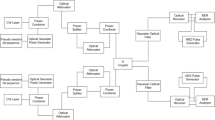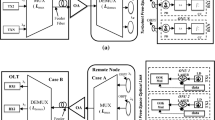Abstract
This work investigates the performance enhancement achieved for an optical communication link designed using co-simulation platform provided by Optisystem and OptiSPICE. A passive optical network with a single channel is designed that employs external Mach–Zehnder modulator at the transmitter and direct detection at the receiver end. The design is first simulated at 2.5 Gbps with Optisystem v.13 only. Externally modulated laser circuit is then designed in OptiSPICE v.5 and this circuit’s co-simulation is done with a design made in Optisystem. The simulation results validate the superior performance obtained when optical components are designed using OptiSPICE that provides more control over user adjustable parameters for different components. The same design parameters can be emulated for practical implementation of Passive optical Network system.







Similar content being viewed by others
References
Lam, C. F. (2007). Passive optical networks: Principles and practice. Oxford: Elsevier.
Praveena, S. M., Vennila, I., & Vaishnavi, R. (2017). Design of wireless passive optical communication network based on fusion of fibre to the home architecture. Wireless Personal Commuications, 96(3), 3851–3871.
Maheswaravenkatesh, P., & Sivanantha, A. R. (2017). A QoS-aware dynamic bandwidth allocation in PON networks. Wireless Personal Communications, 94(4), 2499–2512.
Anis, M. I., Qureshi, M. S., & Zafar, S. (2017). Demonstration of TWDM-PON backward compatibility with conventional GPON. Wireless Personal Commuications, 95(2), 581–592.
Kaur, A., Kaur, B., & Singh, K. (2017). Design and performance analysis of bidirectional TWDM-PON employing QAM-OFDM for downstream and re-modulation for upstream. Optik, 134, 287–294.
Bindhaiq, S., Supa’at, A. M., Zulkifli, N., Mohammad, A. B., Shaddad, R. Q., Elmagzoub, M. A., et al. (2015). Recent development on time and wavelength-division multiplexed passive optical network (TWDM-PON) for next-generation passive optical network stage 2 (NG-PON2). Optical Switching and Networking, 15, 53–66.
https://optiwave.com/category/optispice-manuals/optispice-tutorials/.
Agrawal, G. P. (2002). Fiber-optic communications systems. New York: Wiley.
Keiser, G. (2011). Optical fiber communications. New York: McGraw-Hill Education.
https://optiwave.com/resources/applications-resources/optical-system-optispice-netlist-component/.
Author information
Authors and Affiliations
Corresponding author
Additional information
Publisher's Note
Springer Nature remains neutral with regard to jurisdictional claims in published maps and institutional affiliations.
Rights and permissions
About this article
Cite this article
Kaur, A., Sharma, S. Performance Enhancement of Passive Optical Communication Link with Co-simulation Approach. Wireless Pers Commun 108, 2631–2638 (2019). https://doi.org/10.1007/s11277-019-06542-4
Published:
Issue Date:
DOI: https://doi.org/10.1007/s11277-019-06542-4




